| Oracle® Communications EAGLE Database Administration - GTT User's Guide Release 46.8 F11880-02 |
|
 Previous |
 Next |
| Oracle® Communications EAGLE Database Administration - GTT User's Guide Release 46.8 F11880-02 |
|
 Previous |
 Next |
The GTT Actions allows these actions to be applied to MSUs during global title translation message processing:
Note:
GTT Actions SFTHROT and SFLOG are not supported on GTT-enabled IPSG cards in Release 46.5.A GTT action entry contains one GTT action, a GTT action
ID, data specific to the action, and a reference count. These actions are
contained in a GTT action entry. The EAGLE contain a maximum of 2000 GTT action
entries. A GTT action entry, identified by the GTT action ID, is assigned to a
GTT action set. The GTT action set is assigned to the global title address
entry. The reference count in the GTT action entry shows the number of database
entities GTT action sets that reference the GTT action entry. When a GTT action
entry is referenced by a GTT action set, a service selector ID, or a Forward
GTT action entry, or an LNP service, the reference count is increased by 1.
When a GTT action set, a service selector ID, or a Forward GTT action entry, or
an LNP service no longer references the GTT action entry, the reference count
is decreased by 1. The GTT action entry can be removed only when the reference
count is zero. The data for each GTT action entry is shown in the
rtrv-gttact
output.
Discard GTT Action
ent-gttact command using these
parameters.
actid - the GTT action
ID
act=disc - the discard
GTT action
on=uimreqd - UIM 1193
GTT Action DISCARD DISCARDED MSU is
generated when the MSU is discarded.
off=uimreqd - UIM 1193
GTT Action DISCARD DISCARDED MSU is
not generated when the MSU is discarded.
Note:
If neither theon=uimreqd or
off=uimreqd parameters are
specified, the
UIMREQD value defaults to
off.
An example of the Discard GTT action entry is shown in Figure 2-12.
Figure 2-12 Discard GTT Action Entry

UDTS GTT Action
ent-gttact command using these
parameters.
actid - the GTT action
ID
act=udts - the UDTS
GTT action
udtserr= 0 to 255
on=uimreqd - UIM 1192
GTT Action UDTS DISCARDED MSU is
generated when the MSU is discarded.
off=uimreqd - UIM 1192
GTT Action UDTS DISCARDED MSU is not
generated when the MSU is discarded.
Note:
If neither theon=uimreqd or
off=uimreqd parameters are
specified, the
UIMREQD value defaults to
off.
An example of the UDTS GTT action entry is shown in Figure 2-13.
Figure 2-13 UDTS GTT Action Entry

TCAP Error GTT Action
ent-gttact command using these
parameters.
actid - the GTT action
ID
act=tcaperr - the TCAP
Error GTT action
atcaperr= 0 to 255 -
the ANSI TCAP error code
itcaperr= 0 to 255 -
the ITU TCAP error code
on=uimreqd - UIM 1077
GTT Action TCAP ERROR DISCARDED MSU is
generated when the MSU is discarded.
off=uimreqd - UIM 1077
GTT Action TCAP ERROR DISCARDED MSU is
not generated when the MSU is discarded.
Note:
If neither theon=uimreqd or
off=uimreqd parameters are
specified, the
UIMREQD value defaults to
off.
An example of the TCAP Error GTT action entry is shown in Figure 2-14.
Figure 2-14 TCAP Error GTT Action Entry

Duplicate GTT Action
GTT Action DUPLICATE FAILED is
generated. A Duplicate GTT action entry is provisioned with the
ent-gttact command using these
parameters.
actid - the GTT action
ID
act=dup - the
Duplicate GTT action
pc/pca/pci/pcn/pcn24=the point
code of the duplicate node
ri=<gt, ssn> -
the routing indicator in the SCCP called party address of the duplicated copy
of MSU.
mrnset=<1 - 3000 or
none> - the MRN set ID, shown in the
rtrv-mrn output, or no MRN set ID
mapset=<1 - 36000 or
dflt> - The MAP set ID or the default MAP set ID, shown in the
rtrv-map output
ssn=<2 - 255> -
The subsystem number in the SCCP called party address of the duplicated copy of
MSU.
loopset - the name of
the loopset, shown in the
rtrv-loopset output, associated with
the Duplicate GTT action entry
cggtmodid - the
calling party global title modification identifier, shown in the
rtrv-gtmod output, associated with the
calling party of a GTT action entry.
cdgtmodid - the called
party global title modification identifier, shown in the
rtrv-gtmod output, associated with the
called party of a GTT action entry.
cgpc/cgpca/cgpci/cgpcn/cgpcn24 - the
calling party point code in the outgoing message when the
cgpcogmsg parameter value is
provcgpc. The network type of the
cgpc/cgpca/cgpci/cgpcn/cgpcn24 value
must be the same as the
pc/pca/pci/pcn/pcn24 value.
cgpcogmsg=<dflt, cgpcicmsg,
opcicmsg, provcgpc> - the data that is used as the calling party
point code in the outgoing message.
dflt - default.
The standard Global Title Translation process supplies the calling party
address point code.
Note:
If thecgpc/cgpca/cgpci/cgpcn/cgpcn24 and the
cgpcogmsg parameters are not
specified, the default value for the
cgpcogmsg parameter is
dflt.
cgpcicmsg - the
calling party address point code data from the incoming MSU
opcicmsg - the OPC
data from the incoming MSU
provcgpc - the
cgpc/cgpca/cgpci/cgpcn/cgpcn24 value
provisioned in the Duplicate GTT Action.
on=useicmsg - The
incoming MSU is duplicated to the MSU. The incoming MSU is the MSU before
applying the translation data by any EPAP service or global title translation
process and before applying the GTT actions data. However, it is possible that
some data in the MSU may have been modified by the LIM before arriving on the
service module. The TCAP layer may have been modified by any EPAP service.
off=useicmsg - The
translated MSU is duplicated to the MSU. The translated MSU is the MSU after
applying the translation data by any EPAP/ELAP service or global title
translation process and before applying the GTT actions data. However, it is
possible that some data in the MSU may have been modified by the LIM before
arriving on the service module. The TCAP layer may have been modified by any
EPAP service.
Note:
If neither theon=useicmsg or
off=useicmsg parameters are
specified, the
USEICMSG value defaults to
off.
An example of the Duplicate GTT action entry is shown in Figure 2-15.
Figure 2-15 Duplicate GTT Action Entry

cgpcogmsg parameter value in the
Duplicate GTT action entry,
cgpcogmsg parameter value in the
Duplicate GTT action entry.
dflt for
cgpcogmsg parameter value in the
Duplicate GTT action entry and the CgPA point code or the OPC is not present or
cannot be used in the MSU, The EAGLE uses the
dflt value of the
cgpcogmsg parameter; the CgPA point
code supplied by standard global title translation process is applied.
Forward GTT Action
The Forward GTT action diverts the translated MSU to
another node. If the EAGLE fails to forward the MSU, UIM 1079
GTT Action FORWARD FAILED is generated.
An example of the Forwarded GTT action entry is shown in Figure 2-16.
Figure 2-16 Forward GTT Action Entry

defactid) parameter. The
defactid parameter indicates what action
is taken when the EAGLE fails to route the forwarded MSU. These are the default
actions are:
fallback). The translated MSU is routed according to
the routing data in the translated MSU. The routing data can be from an EPAP
service or the PPSOPTS table, or the global title translation process. Fallback
to the translated MSU is the default value for the
defactid parameter if the
defactid parameter is not specified.
Services GTT Action
GTT Action Services allow triggering a Service as a GTT action either based on the usual GTT rules or after FLOBR/TOBR execution.
An example of the Services GTT action entry is shown in Figure 2-17.
Figure 2-17 Services GTT Action Entry

Any of these three Services can be applied on the translated MSU -GPORT, GFLEX or SMSMR. The new GTT Actions Service cannot be applied on MTP routed MSUs.
GTT Action Services can work with the RTDB Split Feature (240M DN and 240M IMSIs via split database). This compatibility is possible only when GTT Action is executed on GTT enabled LIM cards.
If the Service is triggered by the GTT Action Service fails, the MSU can be processed by applying the results of the pre-Service GTT or processing with the specific Service error.
SFTHROT GTT Action
The SFTHROT GTT Action is used to control the throttling of MSUs on SCCP cards. Thirty-two (32) GTT actions of the type SFTHROT will be allowed. For each such GTT action, the user will provision a threshold as a maximum number of MSUs hitting the GTT action in a 30-second period.
When an MSU hits a GTT action of the type SFTHROT, the SCCP card updates the count of messages that hit the Throttling GTT action and periodically communicates the count to the OAM card via maintenance blocks. The OAM sums the total number of these messages on all SCCP cards, decides if the number of messages has crossed the provisioned threshold, and then communicates to the SCCP card to start throttling the messages.
The OAM will communicate to the SCCP card that the threshold for a particular Throttling GTT action has crossed. The SCCP card will then put that GTT action in the BLOCKED state for the remaining time of the current 30-second window. While the Throttling GTT Action is in the BLOCKED state, any MSU hitting that GTT action will be discarded.
BURSTS - parameter
used to signify the number of previous 30 second windows from where the unused
capacity can be carried over to the current window.
THRESHOLD - If the
count of MSUs hitting SFTHROT action exceeds this value, the MSU will be
discarded.
DEFACTID - Default
Action ID. The default action that is performed when the
sfthrot GTT Action fails.
A GTT Action set will only have a maximum of one SFTHROT GTT Action.
Figure 2-18 Throttling Framework

SFLOG GTT Action
The SFLOG GTT Action is used for logging. An SCCP card will be allowed to log up to 100 log event/second. The SCCP card will transfer all the log events for the MSUs that will hit the SFLOG GTT action. Two IPS cards will act as the Primary and Secondary Logging Card. At any given time, the Primary logging card will be actively logging. The standby logging card will only be used for logging if the active logging card is unavailable for logging for an extended period of time.
Table 2-18 Roles and Responsibilities
| SCCP Card | IPS Logging Card |
|---|---|
| Send the LOG events to the IPS card for the messages that hit the SFLOG GTT action | Determine if it is a primary or standby IPS logging card |
| Peg a system wide Measurement register to indicate overall Log Events in the system | Broadcast that decision to other IPS logging cards and the SCCP cards |
| Use MFC to flow-control messages to IPS card | Receive Log Events from SCCP cards and log them in a file in ASCII Format |
| Raise an Alarm if the logging capacity is exceeded | SFTP the collected log events to the primary server every 15 minutes |
| Raise an Alarm if the primary SFTP server or both the primary and secondary servers cannot be reached |
The SFTP Client interface will enable LOG events to be
transferred from an EAGLE to other workstations. The file naming convention for
the LOG SFTP reports is:
<clli>_sflog_<date in yymmdd
format>_<time in hh24mmss>.pcap. The EAGLE will provide an
SFTP transfer of the LOG files after every 15 minutes. The EAGLE may also be
configured to transfer LOG events periodically to a customer workstation. When
the SFTP Client has been configured and the SFLOG GTT Action has been
configured on some translation, the Logging Framework begins periodic transfers
after collection completes for the next appropriate period.
The LOG event files to be transferred for that collection period are created and stored in IPS RAM Disk. The logging 15 minutes timer will start on both the SFLOG cards, Primary and Secondary (if configured), once the cards come into ACTIVE/IS-NR state. When the LOG event files have been generated, the Primary IPS logging card begins the file transfer to the Primary SFTP Server.
The IPS logging card does not know if an SFTP Server is up and running until it attempts a transfer. If a transfer fails, the transfer to the lowest priority number SFTP Server for the LOG file scheduled for that period is considered a failure, and the Logging system attempts to transfer the LOG file to the next higher priority number SFTP Server. It also raises a MINOR Alarm indicating the failure to transfer to the Primary SFTP Server.
rtrv-ftp-serv command output. The lower
the number in the PRIO column, the higher the server priority.
Note:
Only SFTP servers configured for the SFLOG application are utilized by the Logging Framework for SFTP transfer.If the IPS logging card is unable to establish a connection with any of the SFTP servers, a MAJOR Alarm is generated to record the file transfer failure event, and the LOG file scheduled for transfer is deleted from the file transfer repository. No further attempts are made to regenerate or transfer the file to the SFTP servers.
Release 46.3 implements the SFLOG MFC card service for the MFC interface. The SCCP uses this MFC service to send the log events to the IPS logging cards.
SCCP cards are the MFC client cards and IPS logging cards are MFC server cards for this MFC service. SCCP cards will only send the log event to the active IPS logging card (based on the broadcast message it gets from the active IPS logging card).
<clli>_sflog_<date in yymmdd
format>_<time in hh24mmss>.pcap. The timestamp in the file
name will be the starting time of any 15 minute window.
Note:
If the CLLI is changed, then the SFLOG cards should be booted to reflect the change in the LOG file name.The log file format has the
libpcap format already supported by
EagleEyes.
A GTT Action set will only have a maximum of one SFLOG GTT Action.
SCPVAL GTT Action
SPRM - mandatory
parameter used to decide whether the SCCP NP, NAI and GTA is picked up from
CDPA or CGPA for comparison.
TPRM - mandatory
parameter used to decide whether the MAP digits, NP and NON, are picked from
SMRPDA or SMRPOA for comparison.
NDGT - parameter
used to specify the number of digits that need to be matched between the SCCP
parameter and MAP parameter. The minimum number of digits to match is 1 and the
maximum is 21.
USEICMSG - Use
Incoming Message. Specifies whether to retrieve the data for comparison from
the Original, i.e., as the message was received by SCCP (OFF), or Post-GTT,
i.e., after possible EPAP/GTT translation/modification data has been applied
(ON).
UIMREQD - UIM
Required. On generates a UIM in case of Action failure. Off does not generate a
UIM in case of Action failure.
DEFACTID - Default
Action ID. The default action that is performed when the
scpval GTT Action fails.
Figure 2-19 MAP SCCP Validation Flowchart
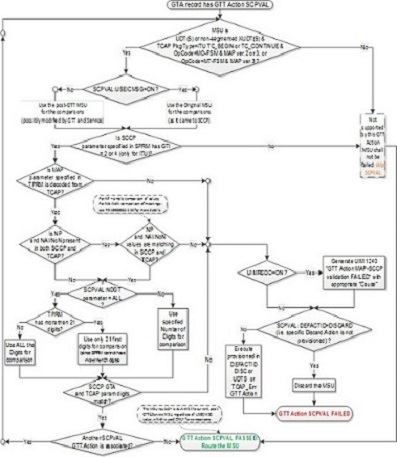
SFAPP GTT Action
The SFAPP GTT action diverts the translated MSU to the SFAPP card.
Figure 2-20 Forward SFAPP GTT Action Entry

The user is able to provision SFAPP card information in the SFAPP GTT Action entry through SCFADDR. HLRADDR is used later on the SFAPP card.
The SFAPP GTT Action is controlled by the "GTT Action -
SFAPP" parameter.
Figure 2-21 SFAPP Action Processing

GTT Action Set
A GTT action set contains from one to six GTT action entries, the GTT action set ID which is used by global title address entries to reference the GTT action set, a test mode field whose value can be either on or off, and a reference count. The EAGLE can contain 20,000 GTT action sets.
A GTT action set is assigned to a global title address
entry. The reference count in the GTT action set shows the number of global
title address entries that reference the GTT action set. When a GTT action set
is referenced by an global title address entry, the reference count is
increased by 1. When a global title address entry no longer references the GTT
action set, the reference count is decreased by 1. The GTT action set can be
removed only when the reference count is zero. When the GTT action set is
removed, the reference counts of GTT action entries that are in the GTT action
set are decreased by 1.The data for each GTT action set is shown in the
rtrv-gttaset
output.
ent-gttaset command with these
parameters.
actsn - the GTT action
set name
actid1 - The GTT
action entry ID shown in the
rtrv-gttact output.
actid2 - The GTT
action entry ID shown in the
rtrv-gttact output.
actid3 - The GTT
action entry ID shown in the
rtrv-gttact output.
actid4 - The GTT
action entry ID shown in the
rtrv-gttact output.
actid5 - The GTT
action entry ID shown in the
rtrv-gttact output.
actid6 - The GTT
action entry ID shown in the
rtrv-gttact output.
on=testmode
off=testmode
actid4 parameter can be specified
without specifying the
actid1 parameter. However, after
specifying the
actid4 parameter with a Duplicate GTT
action entry, the
actid1 parameter cannot be specified
with a GTT action entry that contains either the Forward, Discard, UDTS, TCAP
Error, Services, SFLOG, SFTHROT or SCPVAL GTT action. Another Duplicate GTT
action entry can be specified for the
actid1parameter.
on=testmode -
indicates that the GTT action set is used only by the test message tool.
off=testmode -
indicates that the GTT action set is used for real-time MSU processing.
The default value for the test mode field, if neither the
on=testmode or
off=testmode parameters are specified,
is
off.
GTA Entries and the Discard/UDTS/TCAP Error GTT Action
In previous releases, only the Discard and UDTS GTT actions could be assigned to a GTA entry, but the GTA entry could contain no routing data (the point code, SSN, routing indicator, MRN set and MAP set values). With the GTT Actions feature, the GTA entry that references the GTT action set that contains the Discard, UDTS, or TCAP Error GTT actions can contain routing data, although the routing data is not used during message processing. This allows the user to change the GTT action set that is being referenced by the GTA entry to a GTT action set that requires routing data, a GTT action set that contains either the Duplicate or Forward GTT actions, without having to provision the routing data for the GTA entry.
GTA Entries with the XLAT=NONE Parameter
In previous releases, the Discard and UDTS GTT actions
were specified for the GTA entry with the
xlat=disc and the
xlat=udts parameters of the
ent-gta or
chg-gta commands. The GTT Actions
feature allows a GTA entry to be provisioned with the
xlat=none parameter. The GTA entry that
contains the
xlat=none parameter can contain any data
except the routing data (the point code, SSN, and routing indicator). At any
point of time, in a given GTT set, two GTA entries with same GTA value and
different XLAT values are not allowed.
xlat=none parameter value is found,
these actions occur.
xlat=none parameter value and a
GTT action set and:
xlat=none parameter value and does
not contain a GTT action set, the matching translation is not considered a
match because there is no routing data. If none of the following conditions are
present, the global title translation process has failed.
xlat parameter value other
than
none.
xlat=none parameter value
is found in the advanced portion of CdPA translation, (SELID, OPTSN, or OPCSN),
and no further advanced CdPA processing is possible (for example, there is no
optional OPCSN defined), the next GTT mode in the GTT hierarchy is considered.
For example, while searching for a matching
translation using the Origin-Based SCCP Routing feature, Set 3 Translation is
found (see
Figure 2-22).
A matching translation that contains the
xlat=none parameter value is
found in SELID/Set 4. This is not considered a match. The MSU is routed based
on the routing data in Set 3 Translation.
If Set 3 Translation is a CdPA GTA translation
with an optional OPC set and a matching translation that contains the
xlat=none parameter value is
found in SELID/Set 4, and a matching translation that contains the
xlat=none parameter value is
found in the OPC set also, the next mode in the GTT hierarchy is selected.
Figure 2-22 Origin-Based SCCP Routing and XLAT=NONE
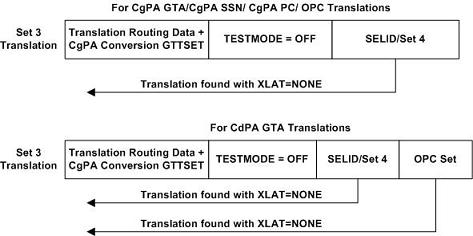
xlat=none parameter value is
encountered, the FALLBACK option of the previously found translation is used.
If the FALLBACK option is set to yes, a match is made to the previously found
translation. If the FALLBACK option is set to no, the global title translation
process has failed. For example, while searching for a matching translation
using the Flexible Linkset Optional Based Routing feature, Set 1 Translation is
found (see
Figure 2-23).
A matching translation that contains the
xlat=none parameter value is found
in SELID/Set 2.This is not a match. The FALLBACK option of Set 1 Translation is
used. Since the FALLBACK option is set to yes in Set 1 Translation, the MSU is
routed based on the Set 1 Translation routing data.
Figure 2-23 Interaction between the FALLBACK Option and XLAT=NONE
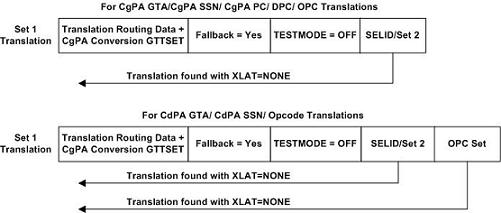
If Set 1 Translation is a CdPA GTA, CdPA SSN, or
Opcode translation and a matching translation that contains the
xlat=noneparameter value is
found in SELID/Set 2 as shown in
Figure 2-22,
a check for a matching translation is made in the OPC set. If a matching
translation that contains the
xlat=noneparameter value is
found in the OPC set, the FALLBACK option of Set 1 Translation is used. Since
the FALLBACK option in Set 1 Translation is set to yes, the MSU is routed based
on the Set 1 Translation routing data. If Set 1 is the very first GTT set that
is found in the searching process and Set 1 Translation is provisioned with the
xlat=none parameter value, then
the global title translation process fails.
GTT Action Per-TT Measurements
GTT action-related events recorded by the SCCP application are reported as system-wide totals, on a per-translation type basis (per-TT), and a per-path basis. The events recorded for GTT Actions are shown in Table 2-19 and Table 2-20.
Table 2-19 GTT Action Events Recorded for Per-TT and System-Wide Measurements Reports
| Event Label | Description |
|---|---|
| GTTASET | The total number of messages receiving any GTT action. |
| GTTADUP | The total number of messages for which a Duplicate MSU was sent. |
| GTTADISC0 | The total number of messages discarded by the DISCARD GTT action. |
| GTTADISC1 | The total number of messages discarded by the UDTS GTT action. |
| GTTADISC2 | The total number of messages discarded by the TCAP Error GTT action. |
| GTTAFWD | The total number of messages forwarded by the Forward GTT action. |
| GTTASRVGFLX | The total number of messages serviced by GFLEX GTT Action. |
| GTTASRVGPRT | The total number of messages serviced by GPORT GTT Action. |
| GTTASRVSMSR | The total number of messages serviced by SMSMR GTT Action. |
Table 2-20 GTT Action Events Recorded for Per-Path Measurements Reports
| Event Label | Description |
|---|---|
| GTTACTNA | The total number of messages for which no GTT actions were performed. |
| GTTADUP | The total number of messages for which a Duplicate MSU was sent. |
| GTTADISC0 | The total number of messages discarded by the DISCARD GTT action. |
| GTTADISC1 | The total number of messages discarded by the UDTS GTT action. |
| GTTADISC2 | The total number of messages discarded by the TCAP Error GTT action. |
| GTTAFWD | The total number of messages forwarded by the Forward GTT action. |
| GTTASRVGFLX | The total number of messages serviced by GFLEX GTT Action. |
| GTTASRVGPRT | The total number of messages serviced by GPORT GTT Action. |
| GTTASRVSMSR | The total number of messages serviced by SMSMR GTT Action. |
The per-translation type report contains a breakdown of the GTT action events for each of the translation types provisioned in the database, up to a maximum of 256 translation types. This data is available for every 30-minute interval, and for every 15-minute interval if the 15-Minute Measurements feature is enabled and turned on. The GTT Actions system-wide measurements report provides the totals of all the actions that were performed on the EAGLE for all the GTT action sets. This report is available for every 30-minute interval, and for every 15-minute interval if the 15-Minute Measurements feature is enabled and turned on.
GTT Action Per-Path Measurements
The GTT action per-path measurements provides measurement
counts for the GTT actions applied to the messages that match a pre defined
combination of “CgPA GTA”, “CdPA GTA”, and “Opcode” values. The combination of
these values are provisioned in the GTT Path table with the
ent-gttapath command. Each entry in the
GTT Path table must be unique combination of CdPA GTA, CgPA GTA and Opcode
values and this combination is called a path. If a translation search in Global
Title Translation table matches the path specified in GTT Path table, then the
corresponding measurement counts for that path are incremented. However, if the
ppmeasreqd parameter (Per Path
Measurements required) value for the final translation is
no, then the per-path measurement counts
for the matching path are not pegged.
ent-gttapath command with these
parameters.
gttpn - the GTT action
path name
opgttsn - the opcode
GTT set name shown in the
rtrv-gttset output.
opcode - the opcode
value shown in the
rtrv-gta output that is assigned to
the
opgttsn value.
pkgtype - the package
type value shown in the
rtrv-gta output that is assigned to
the
opgttsn value.
family - the family
value shown in the
rtrv-gta output that is assigned to
the
opgttsn value.
acn - the ACN value
shown in the
rtrv-gta output that is assigned to
the
opgttsn value.
cggttsn - the CGGTA
GTT set name shown in the
rtrv-gttset output.
cggta - the CGGTA
shown in the
rtrv-gta output that is assigned to
the
cggttsn value.
cdgttsn - the CDGTA
GTT set name shown in the
rtrv-gttset output.
cdgta - the CDGTA
shown in the
rtrv-gta output that is assigned to
the
cggttsn value.
An example of a GTT action path entry is shown in Figure 2-24.
Figure 2-24 GTT Action Path Entry

The GTT Action path table can contain a maximum of 10,000
entries. A GTT path entry shall have up to three GTT set-value combinations in
it, where the GTT set and value must be a valid entry in the GTT Translation
table. However, a GTT path must be provisioned with at least one GTT set and
value (CdPA GTA/CgPA GTA/Opcode). For every GTT action path, the GTT set and
the value must be specified together as a combination. If the GTT Set-value
combination is not provisioned in a GTT action path then it is considered as no
value and is displayed as “----“ in the
rtrv-gttapath output for that
combination. Translation entries cannot be removed or modified (in case of GTA
range splitting) if the entries are referenced in a GTT action path.
Figure 2-25
shows the relation between the two tables.
Figure 2-25 GTT Translation and GTT Action Path Table Relationship
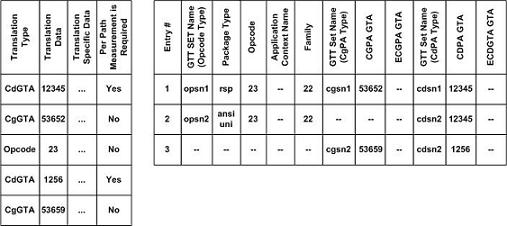
The GTT actions per-path measurements report contains the GTT Action events for the predefined GTT paths that are provisioned in the database, up to a maximum of 10,000 predefined paths. The per-path measurement data is collected during the 60 minute interval period (per hour). The hourly data is retained for 24 hours. The daily collection data is retained for seven days. The data collection reports are available as both scheduled and on-demand reports. The events recorded for the GTT actions per-path measurements is shown in Table 2-20.
ppmeasreqd parameter value in the
global title translation is
yes.
GTT Action Path Entry Searched with all the GTT Set-Value Combinations Specified
All three specified GTT Set-value combinations (opcode/CgPA/CdPA) are provisioned in a GTT action path in GTT action path table as shown in Figure 2-26.
Figure 2-26 Example GTT Action Path Table Entry

ppmeasreqd parameter value in the
global title translation is
yes.
Figure 2-27 GTT Translation Lookup - Exact GTT Action Path Match

This combination matches the entry # 1 in the GTT action path table shown in Figure 2-26. Since the per-path measurement required value is set to Yes in Set 7 (the translation result), entry #1 in Figure 2-26 is pegged in the per-path measurements report. If the per-path measurement required value is set to No in Set 7, then entry #1 in Figure 2-26 is not pegged in the per-path measurements report.
GTT Action Path Entry Not Searched in the Translation Lookup
If a GTT set-value combinations search is performed during the translation lookup, and all the searched combinations do not match any of the provisioned GTT action paths, then the per-path measurements are not pegged.
Figure 2-28 GTT Translation Lookup - No GTT Action Path Match
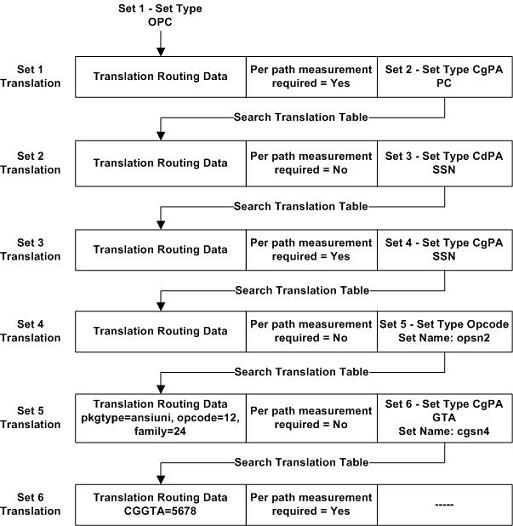
In Figure 2-28, a search is performed for this translation data during the global title translation lookup. CDPA GTA and CgPA GTA searches were not performed.
| Opcode GTT Set Type | Set 5 | OPGTTSN=opsn2 | OPCODE=12 |
The entries in Figure 2-26 do not contain any entries that have only an Opcode entry, so the per-path measurements are not pegged.
GTT Path Entry Searched with Some GTT Set-Value Combinations Specified
Figure 2-29 GTT Translation Lookup - Exact GTT Action Path Match (with Unspecified GTT Set-Value Combinations)
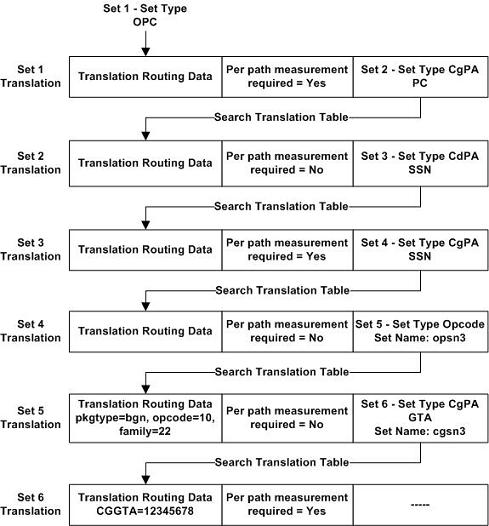
In Figure 2-29, searches are performed for this translation data during the global title translation lookup. CDPA GTA search was not performed
| Opcode GTT Set Type | Set 5 | OPGTTSN=opsn3 | OPCODE=10 |
| CGPA GTT Set Type | Set 6 | CGGTTSN=cgsn3 | CGGTA=12345678 |
The searched CGPA GTA/CdPA GTA/OPCODE values matches Entry #3 in Figure 2-26 where the CDPA GTA is provisioned as none. Since the per-path measurement required value is set to Yes in Set 6 (the translation result), entry #3 in Figure 2-26 is pegged in the per-path measurements report.
Provisioning the GTT Actions Feature
To provision the GTT Actions feature, perform these steps.
chg-feat command. Add the required
service modules to the database using the
ent-card command. Perform the
Adding a Service Module
procedure.
enable-ctrl-feat and the
chg-ctrl-feat commands.
Perform the Activating the GTT Actions Features procedure to enable and turn on these features.
ent-gttact command by performing the
Adding a GTT Action
procedure.
ent-gttaset command by performing the
Adding a GTT Action Set
procedure.
ent-gta command. Perform
Adding Global Title Address Information.
To provision the GTT action paths, perform these steps.
ent-gttset command. Perform
Adding a GTT Set.
ent-gta command. Perform
Adding Global Title Address Information.
ent-gttapath command by performing the
Adding a GTT Action Path Entry
procedure.